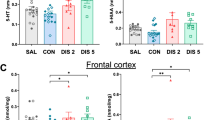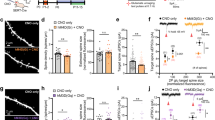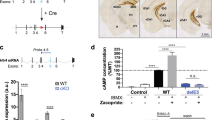Abstract
Few studies have examined the relationship between genetics, stress, and sex-linked differences in neurotransmitter systems. Examining serotonin (5-HT) receptor knockout mice on stress-induced behavioral depression, female 5-HT1B receptor knockout mice demonstrated significantly reduced immobility than either male 5-HT1B receptor knockout mice or male and female wild-type mice on the tail suspension test (TST) and forced swimming test. The behavioral phenotype was identified as likely due to a disinhibition of 5-HT release, because depletion of 5-HT with parachlorophenylalanine selectively reduced immobility of female 5-HT1B receptor knockout mice in the TST. In contrast, male and female 5-HT1A receptor knockout mice demonstrated reduced immobility compared with control mice, but the depletion of 5-HT with PCPA did not reverse the antidepressant-like phenotype. Microdialysis studies confirmed significantly higher baseline levels of hippocampal 5-HT in female, but not male, 5-HT1B receptor knockout mice. Both male and female 5-HT1B receptor knockout mice demonstrated augmented dialysate responses to fluoxetine. Also, both male and female 5-HT1B receptor knockout mice demonstrated reductions of immobility in the TST after treatment with fluoxetine. Therefore, female 5-HT1B receptor knockout mice demonstrate a sex-linked disinhibition of 5-HT release that sustained higher baseline levels of hippocampal 5-HT and behavioral vulnerability to 5-HT depletion.
Similar content being viewed by others
Log in or create a free account to read this content
Gain free access to this article, as well as selected content from this journal and more on nature.com
or
References
Adell A, Celada P, Artigas F (2001). The role of 5-HT1B receptors in the regulation of serotonin cell firing and release in the rat brain. J Neurochem 79: 172–182.
Akiskal HS (1989). New insights into the nature and heterogeneity of mood disorders. J Clin Psychiatry 50 (Suppl): 6–10 ; discussion 11–12.
Artigas F, Bel N, Casanovas JM, Romero L (1996). Adaptative changes of the serotonergic system after antidepressant treatments. Adv Exp Med Biol 398: 51–59.
Bagdy G (1998). Serotonin, anxiety, and stress hormones. Focus on 5-HT receptor subtypes, species and gender differences. Ann NY Acad Sci 851: 357–363.
Biver F, Lotstra F, Monclus M, Wikler D, Damhaut P, Mendlewicz J et al (1996). Sex difference in 5HT2 receptor in the living human brain. Neurosci Lett 204: 25–28.
Boschert U, Amara DA, Segu L, Hen R (1994). The mouse 5-hydroxytryptamine1B receptor is localized predominantly on axon terminals. Neuroscience 58: 167–182.
Bouali S, Evrard A, Chastanet M, Lesch KP, Hamon M, Adrien J (2003). Sex hormone-dependent desensitization of 5-HT1A autoreceptors in knockout mice deficient in the 5-HT transporter. Eur J Neurosci 18: 2203–2212.
Cesana R, Ceci A, Ciprandi C, Borsini F (1993). Mesulergine antagonism towards the fluoxetine anti-immobility effect in the forced swimming test in mice. J Pharm Pharmacol 45: 473–475.
Chaput Y, Lesieur P, de Montigny C (1990). Effects of short-term serotonin depletion on the efficacy of serotonin neurotransmission: electrophysiological studies in the rat central nervous system. Synapse 6: 328–337.
Cidis Meltzer C, Drevets WC, Price JC, Mathis CA, Lopresti B, Greer PJ et al (2001). Gender-specific aging effects on the serotonin 1A receptor. Brain Res 895: 9–17.
Cryan JF, Valentino RJ, Lucki I (in press). Assessing substrates underlying the behavioral effects of antidepressants using the modified rat forced swimming test. Neurosci Biobehav Rev.
Delgado PL, Miller HL, Salomon RM, Licinio J, Krystal JH, Moreno FA et al (1999). Tryptophan-depletion challenge in depressed patients treated with desipramine or fluoxetine: implications for the role of serotonin in the mechanism of antidepressant action. Biol Psychiatry 46: 212–220.
Ellenbogen MA, Young SN, Dean P, Palmour RM, Benkelfat C (1996). Mood response to acute tryptophan depletion in healthy volunteers: sex differences and temporal stability. Neuropsychopharmacology 15: 465–474.
Engel G, Gothert M, Hoyer D, Schlicker E, Hillenbrand K (1986). Identity of inhibitory presynaptic 5-hydroxytryptamine (5-HT) autoreceptors in the rat brain cortex with 5-HT1B binding sites. Naunyn-Schmiedeberg's Arch Pharmacol 332: 1–7.
Frackiewicz EJ, Sramek JJ, Cutler NR (2000). Gender differences in depression and antidepressant pharmacokinetics and adverse events. Ann Pharmacother 34: 80–88.
Franklin KBJ, Paxinos G (1997). The Mouse Brain in Stereotaxic Coordinates. Academic Press: San Diego.
Gross C, Zhuang X, Stark K, Ramboz S, Oosting R, Kirby LG et al (2002). Serotonin1A receptor acts during development to establish normal anxiety-like behaviour in the adult. Nature 416: 396–400.
Gundlah C, Simon LD, Auerbach SB (1998). Differences in hypothalamic serotonin betweeen estrous phases and gender: an in vivo microdialysis study. Brain Res 785: 91–96.
Handley SL, Dunn TL, Waldron G, Baker JM (1980). Tryptophan, cortisol and puerpural mood. Br J Psychiatry 136: 498–508.
Hasegawa Y, Higuchi S, Matsushita S, Miyaoka H (2002). Association of a polymorphism of the serotonin 1B receptor gene and alcohol dependence with inactive aldehyde dehydrogenase-2. J Neural Transm 109: 513–521.
Hjorth S (1993). Serotonin 5-HT1A autoreceptor blockade potentiates the ability of the 5-HT reuptake inhibitor citalopram to increase nerve terminal output of 5-HT in vivo: a microdialysis study. J Neurochem 60: 776–779.
Hjorth S, Auerbach SB (1994). Further evidence for the importance of 5-HT1A autoreceptors in the action of selective serotonin reuptake inhibitors. Eur J Pharmacol 260: 251–255.
Joffe H, Cohen LS (1998). Estrogen, serotonin, and mood disturbance: where is the therapeutic bridge? Biol Psychiatry 44: 798–811.
Kessler RC (2003). Epidemiology of women and depression. J Affect Dis 74: 5–13.
Kessler RC, McGonagle KA, Nelson CB, Hughes M, Swartz M, Blazer DG (1994). Sex and depression in the National Comorbidity Survey. II: Cohort effects. J Affect Dis 30: 15–26.
Knobelman DA, Hen R, Blendy JA, Lucki I (2001a). Regional patterns of compensation following genetic deletion of either 5-hydroxytryptamine1A and 5-hydroxytryptamine1B in the mouse. J Pharmacol Exp Ther 298: 1092–1100.
Knobelman DA, Hen R, Lucki I (2001b). Genetic regulation of extracellular serotonin by 5-hydroxytryptamine1A and 5-hydroxytryptamine1B autoreceptors in different brain regions of the mouse. J Pharmacol Exp Ther 298: 1083–1091.
Knobelman DA, Kung HF, Lucki I (2000). Regulation of extracellular concentrations of 5-hydroxytryptamine (5-HT) in mouse striatum by 5-HT1A and 5-HT1B receptors. J Pharmacol Exp Ther 292: 1111–1117.
Kornstein SG, Schatzberg AF, Thase ME, Yonkers KA, McCullough JP, Keitner GI et al (2000). Gender differences in treatment response to sertraline versus imipramine in chronic depression. Am J Psychiatry 157: 1445–1452.
Kreiss DS, Weiland S, Lucki I (1993). The presence of a 5-HT uptake inhibitor alters pharmacological manipulations of 5-HT release. Neuroscience 52: 295–301.
Li Q, Wichems C, Heils A, Lesch KP, Murphy DL (2000). Reduction in the density and expression, but not G-protein coupling, of serotonin receptors (5-HT1A) in 5-HT transporter knock-out mice: gender and brain region differences. J Neurosci 20: 7888–7895.
Lucki I (2001). A prescription to resist proscriptions for murine models of depression. Psychopharmacology 153: 395–398.
Lucki I, Dalvi A, Mayorga AJ (2001). Sensitivity to the effects of pharmacologically selective antidepressants in different strains of mice. Psychopharmacology 155: 315–322.
Maes M, Verkerk R, Bonaccorso S, Ombelet W, Bosmans E, Scharpe S (2002). Depressive and anxiety symptoms in the early puerperium are related to increased degradation of tryptophan into kynurenine, a phenomenon which is related to immune activation. Life Sci 71: 1837–1848.
Malagie I, David DJ, Jolliet P, Hen R, Bourin M, Gardier AM (2002). Improved efficacy of fluoxetine in increasing hippocampal 5-hydroxytryptamine outflow in 5-HT1B receptor knock-out mice. Eur J Pharmacol 443: 99–104.
Malagie I, Trillat AC, Bourin M, Jacquot C, Hen R, Gardier AM (2001). 5-HT1B autoreceptors limit the effects of selective serotonin re-uptake inhibitors in mouse hippocampus and frontal cortex. J Neurochem 76: 865–871.
Martenyi F, Dossenbach M, Mraz K, Metcalfe S (2001). Gender differences in the efficacy of fluoxetine and maprotiline in depressed patients: a double-blind trial of antidepressants with serotonergic or norepinephrinergic reuptake inhibition profile. Eur Neuropsychopharmacol 11: 227–232.
Maswood S, Stewart G, Uphouse L (1995). Gender and estrous cycle effects of the 5-HT1A agonist, 8-OH-DPAT, on hypothalamic serotonin. Pharmacol Biochem Behav 51: 807–813.
Maswood S, Truitt W, Hotema M, Caldarola-Pastuszka M, Uphouse L (1999). Estrous cycle modulation of extracellular serotonin in mediobasal hypothalamus: role of the serotonin transporter and terminal autoreceptors. Brain Res 831: 146–154.
Mayorga AJ, Dalvi A, Page ME, Zimov-Levinson S, Hen R, Lucki I (2001). Antidepressant-like behavioral effects in 5-hydroxytryptamine(1A) and 5-hydroxytryptamine(1B) receptor mutant mice. J Pharmacol Exp Ther 298: 1101–1107.
McEwen BS, Alves SE, Bulloch K, Weiland NG (1998). Clinically relevant basic science studies of gender differences and sex hormone effects. Psychopharmacol Bull 34: 251–259.
Moret C, Briley M (1997). 5-HT autoreceptors in the regulation of 5-HT release from guinea pig raphe nucleus and hypothalamus. Neuropharmacology 36: 1713–1723.
Murray CJ, Lopez AD (1997). Alternative projections of mortality and disability by cause 1990–2020: Global Burden of Disease Study (comment). Lancet 349: 1498–1504.
Nishizawa S, Benkelfat C, Young SN, Leyton M, Mzengeza S, de Montigny C et al (1997). Differences between males and females in rates of serotonin synthesis in human brain. Proc Natl Acad Sci USA 94: 5308–5313.
Palego L, Marazziti D, Rossi A, Giannaccini G, Naccarato AG, Lucacchini A et al (1997). Apparent absence of aging and gender effects on serotonin 1A receptors in human neocortex and hippocampus. Brain Res 758: 26–32.
Parker G, Parker K, Austin MP, Mitchell P, Brotchie H (2003). Gender differences in response to differing antidepressant drug classes: two negative studies. Psychol Med 33: 1473–1477.
Parsons LH, Kerr TM, Tecott LH (2001). 5-HT1A receptor mutant mice exhibit enhanced tonic, stress-induced and fluoxetine-induced serotonergic neurotransmission. J Neurochem 77: 607–617.
Pfaff DW (1997). Hormones, genes, and behavior. Proc Natl Acad Sci USA 94: 14213–14216.
Porsolt RD, Anton G, Blavet N, Jalfre M (1978). Behavioural despair in rats: a new model sensitive to antidepressant treatments. Eur J Pharmacol 47: 379–391.
Sanders AR, Cao Q, Taylor J, Levin TE, Badner JA, Cravchik A et al (2001). Genetic diversity of the human serotonin receptor 1B (HTR1B) gene. Genomics 72: 1–14.
Sanders AR, Duan J, Gejman PV (2002). DNA variation and psychopharmacology of the human serotonin receptor 1B (HTR1B) gene. Pharmacogenomics 3: 745–762.
Santarelli L, Saxe M, Gross C, Surget A, Battaglia F, Dulawa S et al (2003). Requirement of hippocampal neurogenesis for the behavioral effects of antidepressants. Science 301: 805–809.
Schrocksnadel K, Widner B, Bergant A, Neurauter G, Schennach H, Schrocksnadel H et al (2003). Longitudinal study of tryptophan degradation during and after pregnancy. Life Sci 72: 785–793.
Serretti A, Lorenzi C, Lilli R, Smeraldi E (2000). Serotonin receptor 2A, 2C, 1A genes and response to lithium prophylaxis in mood disorders. J Psychiatr Res 34: 89–98.
Stanford SC (1996). Prozac: panacea or puzzle? Trends Pharmacol Sci 17: 150–154.
Steru L, Chermat R, Thierry B, Simon P (1985). The tail suspension test: a new method for screening antidepressant drugs. Psychopharmacology 85: 367–370.
Sun HF, Chang YT, Fann CS, Chang CJ, Chen YH, Hsu YP et al (2002). Association study of novel human serotonin 5-HT(1B) polymorphisms with alcohol dependence in Taiwanese Han. Biol Psychiatry 51: 896–901.
Waeber C, Dietl MM, Hoyer D, Palacios JM (1989). 5.HT1 receptors in the vertebrate brain. Regional distribution examined by autoradiography. Naunyn-Schmiedeberg's Arch Pharmacol 340: 486–494.
Weissman MM, Olfson M (1995). Depression in women: implications for health care research. Science 269: 799–801.
Williams RB, Marchuk DA, Gadde KM, Barefoot JC, Grichnik K, Helms MJ et al (2003). Serotonin-related gene polymorphisms and central nervous system serotonin function. Neuropsychopharmacology 28: 533–541.
Yan QS, Yan SE (2001). Activation of 5-HT(1B/1D) receptors in the mesolimbic dopamine system increases dopamine release from the nucleus accumbens: a microdialysis study. Eur J Pharmacol 418: 55–64.
Zhang L, Ma W, Barker JL, Rubinow DR (1999). Sex differences in expression of serotonin receptors (subtypes 1A and 2A) in rat brain: a possible role of testosterone. Neuroscience 94: 251–259.
Acknowledgements
This research was supported by USPHS grants MH 14654 and MH 48125.
Author information
Authors and Affiliations
Corresponding author
Rights and permissions
About this article
Cite this article
Jones, M., Lucki, I. Sex Differences in the Regulation of Serotonergic Transmission and Behavior in 5-HT Receptor Knockout Mice. Neuropsychopharmacol 30, 1039–1047 (2005). https://doi.org/10.1038/sj.npp.1300664
Received:
Revised:
Accepted:
Published:
Issue date:
DOI: https://doi.org/10.1038/sj.npp.1300664
Keywords
This article is cited by
-
ASMT determines gut microbiota and increases neurobehavioral adaptability to exercise in female mice
Communications Biology (2023)
-
Effects of the dopamine depleting agent tetrabenazine in tests evaluating different components of depressive-like behavior in mice: sex-dependent response to antidepressant drugs with SERT and DAT blocker profiles
Psychopharmacology (2023)
-
The 5-HT1B receptor - a potential target for antidepressant treatment
Psychopharmacology (2018)
-
Transgenic mice lacking CREB and CREM in noradrenergic and serotonergic neurons respond differently to common antidepressants on tail suspension test
Scientific Reports (2017)
-
A Lack of Serotonin 1B Autoreceptors Results in Decreased Anxiety and Depression-Related Behaviors
Neuropsychopharmacology (2016)



